TLDR
- The U.S. government shut down at 12:01 a.m. ET Wednesday after the Senate failed to pass a temporary funding bill, with Republicans getting 55 votes instead of the 60 needed
- About 750,000 federal employees will be furloughed without pay, marking the first shutdown since the 2018-19 stoppage during Trump’s first term
- Economic data releases will be delayed starting with Friday’s September jobs report as agencies like the Bureau of Labor Statistics cease operations
- New tariffs on pharmaceutical products and heavy-duty trucks went into effect Wednesday, with 100% duties on some pharmaceuticals and 25% on heavy trucks
- President Trump stated the government could “do things during the shutdown that are irreversible” and threatened mass firings of federal employees
The federal government entered a shutdown early Wednesday morning after lawmakers failed to reach an agreement on funding before the midnight deadline. The Senate held two votes Tuesday evening but neither the Republican nor Democratic proposals received enough support to pass.
Government Shutdown Facts The Media Won't Cover:
1. The average length of a shutdown is only ~8 days
2. The S&P 500 has ended higher one year after a shutdown in 86% of cases
3. The S&P 500 posts an average gain of +13% one year after the shutdown ends
4. During the 35 day…
— The Kobeissi Letter (@KobeissiLetter) October 1, 2025
Republicans needed 60 votes to approve their temporary funding bill but only received 55 votes, with 45 senators voting against it. Three Democratic caucus members crossed party lines to vote with Republicans. The disagreement centered on healthcare subsidies under the Affordable Care Act, which Democrats wanted included in the funding bill while Republicans preferred to address separately.

The shutdown began at 12:01 a.m. ET as the new fiscal year started. This marks the first government shutdown since the 2018-19 stoppage, which lasted seven weeks and became the longest in American history.
Federal agencies are now implementing contingency plans that will send approximately 750,000 government workers home without pay. The Congressional Budget Office estimates this represents about one-third of all federal employees. Many workers classified as essential will be required to continue working without receiving paychecks during the shutdown.
Impact on Economic Data
The Bureau of Labor Statistics will completely cease operations during the shutdown. The agency plans to reduce its workforce from 2,055 employees to just one full-time employee. This means Friday’s September jobs report will be delayed.
The Commerce Department will also halt operations at both the U.S. Census Bureau and Bureau of Economic Analysis. These agencies produce economic data that financial markets and the Federal Reserve use for decision-making. The Fed’s interest rate deliberations scheduled for late October could be affected if the data blackout continues.
Essential Services Continue
Medicare benefits and Social Security checks will continue to be distributed during the shutdown. The U.S. Postal Service will maintain mail delivery since it operates through stamp sales rather than government funding. The Federal Reserve can continue operations because it is largely self-funded.
Air traffic controllers and Transportation Security Administration agents at airports must continue working despite not receiving paychecks. The 2018 shutdown saw higher unscheduled absences among TSA workers, which led to some airport disruptions.
New Tariffs Take Effect
The shutdown coincides with new tariffs going into effect Wednesday. President Trump implemented 100% duties on branded or patented pharmaceutical products, though the policy includes exemptions for companies building facilities in the United States. Pfizer recently secured a three-year grace period from these tariffs as part of an agreement to lower some U.S. drug prices.
The administration also imposed 25% tariffs on heavy-duty trucks to protect American manufacturers. Mexico is watching this development closely as officials await clarification on whether the United States-Mexico-Canada Agreement provides an exception.
Senate Majority Whip John Barrasso told reporters that additional votes could be scheduled throughout the weekend. Lawmakers are working to determine how quickly they can reach a compromise to end the funding lapse.
President Trump stated Tuesday that “we can do things during the shutdown that are irreversible” and suggested “a lot of good can come down from shutdowns.” He has repeatedly mentioned the possibility of mass firings of federal employees, though government contingency plans reviewed by Bloomberg showed little detail about permanent staffing reductions.
This week also marked the final day for tens of thousands of government employees who accepted the Department of Government Efficiency’s “fork in the road” program earlier this year. National parks will remain mostly open during the shutdown, though many park workers will be furloughed.
The Congressional Budget Office said the economic impact depends on how long the shutdown lasts. Past funding lapses have resulted in small drags on economic growth. Markets are monitoring both the shutdown duration and whether policymakers can find solutions to end the gridlock.
Stay Ahead of the Market with Benzinga Pro!
Want to trade like a pro? Benzinga Pro gives you the edge you need in today's fast-paced markets. Get real-time news, exclusive insights, and powerful tools trusted by professional traders:
- Breaking market-moving stories before they hit mainstream media
- Live audio squawk for hands-free market updates
- Advanced stock scanner to spot promising trades
- Expert trade ideas and on-demand support



